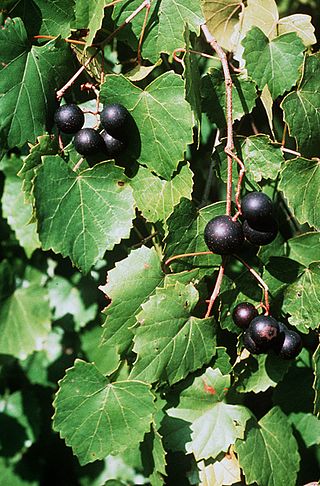
Vitis rotundifolia, or muscadine, is a grapevine species native to the southeastern and south-central United States. The growth range extends from Florida to New Jersey coast, and west to eastern Texas and Oklahoma. It has been extensively cultivated since the 16th century. The plants are well-adapted to their native warm and humid climate; they need fewer chilling hours than better known varieties, and thrive in summer heat.

Vitis aestivalis, the summer grape, or pigeon grape is a species of grape native to eastern North America from southern Ontario east to Maine, west to Oklahoma, and south to Florida and Texas. It is a vigorous vine, growing to 10 m or more high in trees. The leaves are 7–20 cm long, suborbicular, and usually a little broader than long; they are variable in shape, from unlobed to deeply three- or five-lobed, green above, and densely hairy below. The flowers are produced at every 3rd node in a dense panicle 5–15 cm long. The fruit is a small grape 5–14 mm diameter, dark purple or black in colour. It is the official state grape of Missouri. Summer grape prefers a drier upland habitat.

Vitis cinerea, the graybark grape, is a variety of grape. It has small black berries that are mildly unpleasant to eat. Plentiful in Missouri and Louisiana, it is also found throughout the eastern half of the US as far west as Texas, north to Illinois, and south to Florida. It is also known by the name winter grape or possum grape.

Vitis californica, with common names California wild grape, Northern California grape, and Pacific grape, is a wild grape species widespread across much of California as well as southwestern Oregon.
Vitis × doaniana is a hybrid grape resulting from the natural hybridization of Vitis mustangensis with Vitis acerifolia. Its native range is the U.S. states of Oklahoma, Colorado, Texas, and New Mexico.

Vitis mustangensis, commonly known as the mustang grape, is a species of grape that is native to the southern United States. Its range includes parts of Mississippi, Alabama, Louisiana, Texas, and Oklahoma.
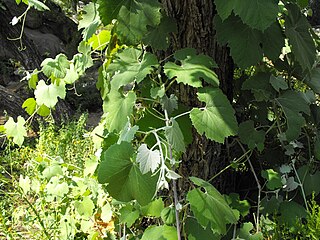
Vitis girdiana is as species of wild grape known as the desert wild grape, coyote grape, or valley grape. It is native to southern California in the United States and to Baja California in Mexico.

Psilostrophe, the paperflowers is a genus of North American plants in the sneezeweed tribe within the sunflower family.
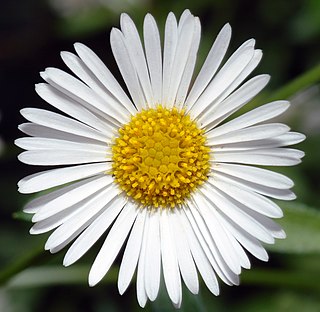
Erigeron karvinskianus, the Mexican fleabane, is a species of daisy-like flowering plant in the family Asteraceae, native to Mexico and parts of Central America.

Vitis davidii is a species of vining plant native to Asia. The plant grows to a height of up to 8 m (25 ft) and bears small, black grapes. It is also known as the Chinese bramble grape.

Aphanostephus (dozedaisy) is a genus of flowering plants in the family Asteraceae.

Amblyolepis is a genus of flowering plants in the daisy family described as a genus in 1836.

Nananthea is a genus of flowering plants in the chamomile tribe within the daisy family.
Vitis balansana is a species of climbing vine in the grape family native to temperate and tropical Asia. Its native range encompasses Vietnam and three southeastern provinces in China The habitat of V. balansana varies; it has adapted to living under forest cover, and in sun-soaked shrubland valleys, at between 200 and 800 meters.

Vitis vulpina is a North American species of herbaceous perennial vines in the grape family. It is widespread across most of the eastern and central United States as well as the Canadian Province of Ontario.
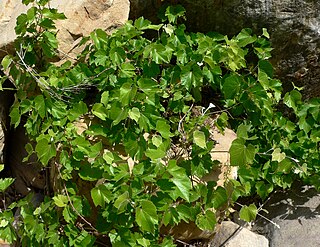
Vitis arizonica is a North American species of wild grape. It is a deciduous vine.
Vitis popenoei, commonly called the totoloche, or totoloche grape, is a New World species of liana in the grape family native to Belize, Mexico, and north-central Guatemala.
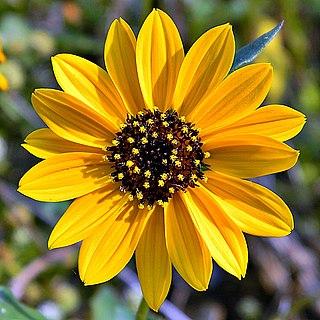
Helianthus debilis is a species of sunflower known by the common names cucumberleaf sunflower, beach sunflower, weak sunflower, and East Coast dune sunflower. It is native to the United States, where it can be found along the Atlantic and Gulf Coasts. It is known elsewhere as an introduced species, such as South Africa, Australia, Taiwan, Slovakia, and Cuba.
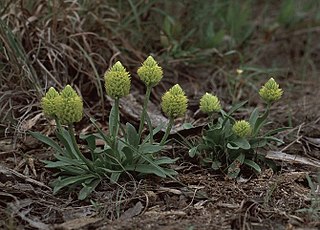
Senega nana, commonly known as candyroot or low bachelors' buttons, is a small species of herbaceous plant native to the south-eastern United States. The root has a sweet liquorice flavor when it is chewed, but it is usually hidden underground until the plant flowers. The seeds of candyroot are dispersed by ants.
Vitis × champinii, or Champin's grape, is a hybrid grape resulting from the natural hybridization of Vitis mustangensis with Vitis rupestris. Its native range is the Edwards Plateau in Texas.



















